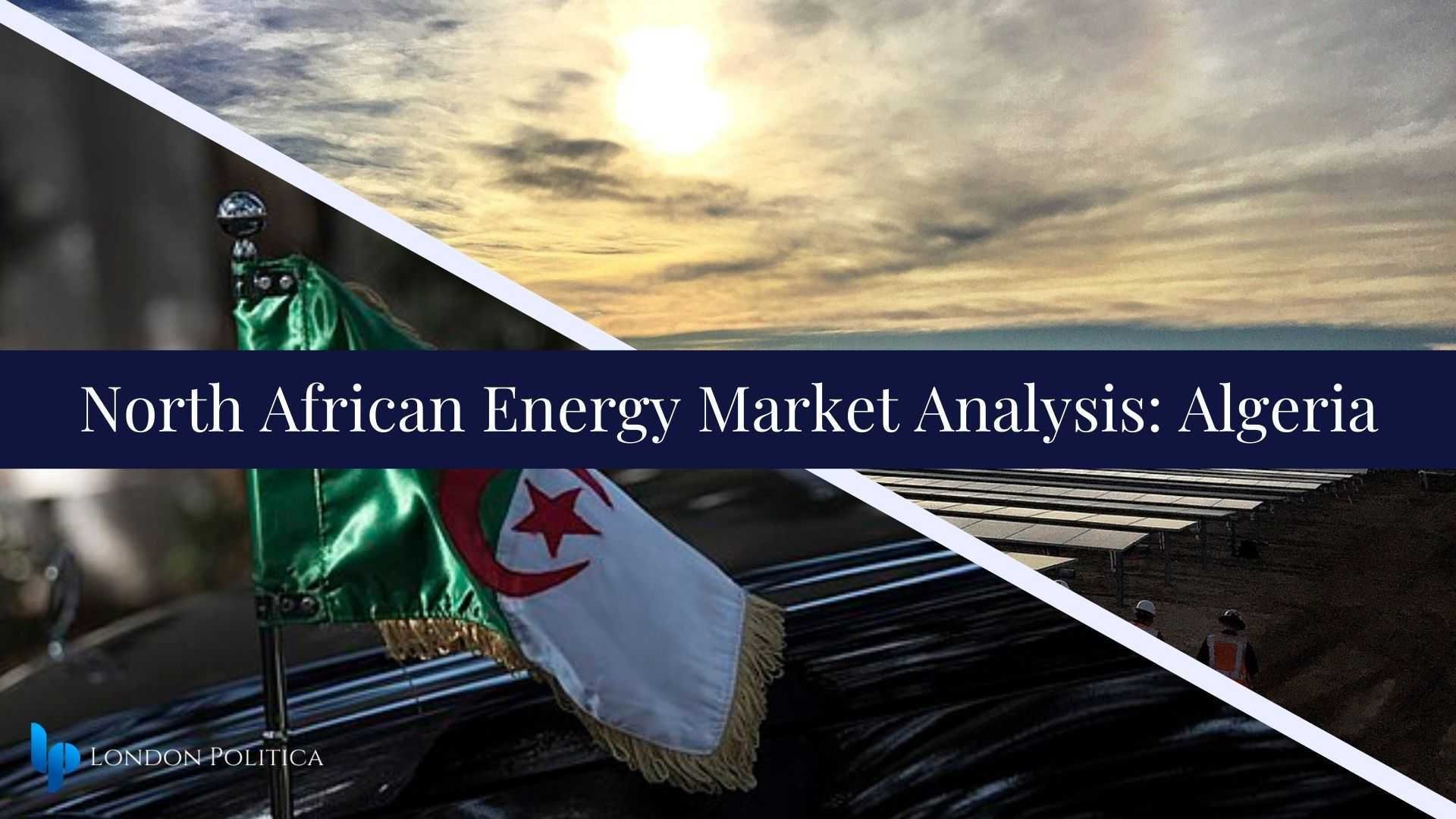North African Energy Market Analyis: Libya
On the 3rd of July, Khalifa Haftar, head of the Libyan National Army, threatened to use armed force unless the politically fragmented country could agree on a mechanism for the “fair” distribution of oil revenues. The deadline set by the military leader is 31 August (today). The potential for another civil war is high and this will have large implications for major commodity markets like crude oil as well as natural gas. The intervention of regional and extra-regional powers further complicates Libya’s chaotic political situation, with different countries backing opposing governments.
Read here for London Politica’s latest report on the situation in Libya, a collaborative analysis from team members from Global Commodities and MENA Watch research programmes.
North African Energy Market Analysis: Algeria
This report serves as an overview of the risks – mainly political, economic, social – in the Algerian energy market. It will look at natural gas, as well as crude oil and green energy. The report is also part of a broader series of analyses on North African energy markets.
Powering the future: Cobalt in the EV battery value chain
Powering the future: Cobalt in the EV battery value chain
This research paper sheds light on the key risks associated with the supply of cobalt, a critical mineral for the production of electric vehicle (EV) batteries. With demand for EVs projected to grow steadily in the coming decade, it is crucial that companies mitigate these risks. The concentration of finite cobalt reserves in the Democratic Republic of the Congo (DRC) and the concentration of refining capacities in China create a delicate balance of supply that is highly risk prone.
Lithium in Iran: Iranian Gold is Black & White
Iran's Ministry of Industry, Mine, and Trade has declared that a significant discovery of 8.5 million tonnes of lithium has been made in Qahavand, Hamadan. The discovery puts Iran in possession of the largest lithium reserve outside of South America. Furthermore, the Ministry has indicated that there could be even more significant amounts of lithium to be discovered in Hamadan in the future. These developments position Iran to potentially overtake Australia as the top supplier of lithium in the world, although it will be heavily reliant on Iran's diplomatic trajectory.
Background
Lithium is widely referred to as "white gold", similar to petroleum being “black gold”, and is a critical element in the shift towards green energy. It serves as a fundamental component in lithium-ion batteries, the primary energy storage system in electric vehicles (EVs). While lithium-ion batteries have been employed in portable electronic devices for several years, their use in EVs is growing rapidly. By 2030, it is anticipated that 95 per-cent of global lithium demand will be for battery production. However, the price of lithium has been declining for several months, and the recent discovery of Iran's reserve is expected to continue this trend. The extent of the impact on global markets will depend on Iran's ability to export and their production capacity.
Iran's economy is facing significant challenges due to a combination of domestic and international factors. The country has been under severe economic sanctions from the United States since 2018, which has severely impacted its ability to trade with other countries and access the global financial system. The ongoing protests and civil unrest have also taken a toll on Iran's economy. Inflation has been a major problem in Iran, with the annual inflation rate reaching over 40% in 2022. This has led to a decline in the purchasing power of the Iranian currency, the rial, and made it difficult for many Iranians to afford basic necessities.
Analysis
Given Iran's current domestic instabilities, the new find will likely be used as a tool to stabilise the Rial (IRR) which is especially volatile due to international sanctions adversely impacting the country and international political disputes, like the developments linked to the JCPOA. However, as extraction is not planned to begin till 2025, there will not be any real direct short-term economic relief; the government will have to rely on the market’s reaction to future potential.
The discovery will also have diplomatic and foreign policy implications. According to IEA projections, the concentration of lithium demand will be in the United States, the European Union and China. Iran can leverage the necessity of lithium supply to the energy transition and net-zero emission goals as a bargaining chip in future negotiations with Western powers over sanctions relief and its nuclear activities. Iran's growing and diversifying portfolio of essential commodities is a potential threat to those pushing for its exclusion from global trading networks. The new discovery can even act as a catalyst for Iranian membership in BRICS.
China has long-standing economic and political ties with Iran, even amidst Western sanctions. China has been a significant importer of Iranian oil, and in recent years, they have invested heavily in Iranian infrastructure and other sectors. With the discovery of a large lithium reserve in Iran, China is primed to take advantage of its relationship to further pursue its trade interests for rare earth minerals. This could further strengthen the economic ties between the two countries, and also create a new avenue for diplomatic relations. However, the relationship between China and Iran is not without its complications. China's increasing involvement and improved relationship with Iran's regional rivals such as Saudi Arabia has raised concerns in Tehran.
Despite these challenges, the potential economic benefits of the lithium discovery in Iran are significant enough that China is likely to overlook some of these complications and Iran can strengthen its diplomatic ties with political powerhouse. The demand for lithium is expected to increase exponentially in the coming years, particularly in China, which has set ambitious targets for the adoption of electric vehicles. Therefore, the availability of Iranian lithium could be a significant boost to China's domestic EV industry.
Powering the future: Lithium in the EV battery value chain
Powering the future: Lithium in
the EV battery value chain
This research paper is the first in a series covering the numerous risks associated with electric vehicle (EV) battery production. Each paper delves into a specific mineral that is vital to this process, starting off with lithium. This series is brought by a team of analysts from the Global Commodities Watch.
Russia attacks Ukrainian Energy Infrastructure
Ukrainian energy infrastructure has suffered immense attacks by Russia since its invasion of Ukraine in February 2022. Since Ukraine’s attack on 8 October on Kerch Bridge, which links Russia to annexed Crimea, Vladimir Putin has increased its air strikes against Ukraine’s energy infrastructure. This follows Russia’s capture of the Zaporizhzhia nuclear power station in Ukraine and recent attacks on the Nord Stream natural gas pipeline in the Baltic Sea, which supplies energy from Russia to Europe. According to the UK Ministry of Defence, Russia likely intends “to cause widespread damage to Ukraine’s energy distribution network”, especially as winter approaches. As of October 2022, nearly 40% of energy infrastructure has been damaged or destroyed and Ukrainians have been urged to stockpile on emergency essentials such as water, blankets, and socks.
As part of a wave of strikes since 10 October, Russian missiles have damaged the offices of Ukraine’s electric transmission company energy in Kyiv, as well as eight energy facilities in Lviv, Burshtyn, Ladyzhyn, Kryvyi Rih, Konotop, and Kyiv. The upswing in Russian military operations directed at Ukrainian energy infrastructure has and will continue to have substantial geopolitical consequences and contribute to increased tension in strategic relationships. President Zelensky claims the increased attacks are aimed at initiating a refugee exodus, especially as winter creeps closer and greater heating is required to keep households warm; the realisation of this aim will, without doubt, further burden the strained energy systems of EU countries that choose to host Ukrainian refugees. The likely increase in emigration from Ukraine into neighbouring EU countries, and even Russia, will reduce civilian resistance to Russian operations geared towards the annexation of Ukraine. With resistance warfare having been key to Ukraine’s defences in certain regions, emigration out of Ukraine will inflate Russia’s chances of success.
The weapons used in these attacks are of particular importance for analysing the conflict's geopolitical consequences. The employment of Iranian air-to-surface missiles, the Shahed-136, and the possible deployment of the Fateh-110 and Zolfaghar, short-range surface-to-surface ballistic missiles has been highlighted recently; the provision of weapons and the Russo-Iranian partnership will further antagonise Western powers and solidify the growing East-West rivalry in current geopolitics. With fresh EU sanctions placed on Iranian entities and officials, the chances of a revived JCPOA agreement, commonly known as the "Iran nuclear deal", continue to look bleak. The EU had been pushing for the revival of the deal struck in 2015. This has rapidly changed following the current civilian uprising in Iran, supply of weapons to Russia and the reluctance of the US to further negotiate. The hope the EU held for Iran rejoining the energy market and the lower oil prices this could have led to has been lost.
To combat Russian airstrikes, Ukraine has officially requested Israeli expertise in air defence, including the Iron Dome and Iron Beam. The request creates a dilemma for Israeli officials and could create new tensions in its relationship with both the West and Russia. Israeli officials must conduct a cost-benefit analysis. There is the benefit of testing the technology and gathering information on its functionality against Iranian weapons but the Israeli government must also consider the Jewish population in Russia, the Russian diaspora in Israel as well as the current Iranian position in Syria. There is a current threat of the Jewish Agency that facilitates the immigration of Jews to Israel in Russia being shut down. It would make it very tough for Jews in Russia to immigrate to Israel if they wish. That is especially important in the present as some Russian youths are searching for ways to escape being enlisted. There are also fears of further Russian involvement in Syria in support of Iran if diplomatic ties between Russia and Israel become strained, including Russia’s current neutrality towards Israeli attacks.
Potash supply in a de-globalising world
International sanction regimes are disrupting supply chains across the world. In this research paper, analysts from London Politica’s Global Commodities Watch (GCW) provide an overview of the major stakeholders, critical infrastructure, trade routes, supply and demand side risks, and forecasted trends for potash.
Potash is a fertiliser, essential for increasing agricultural yields and feeding the growing population of the world.












